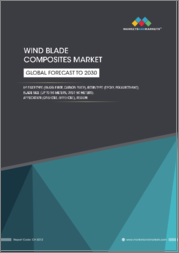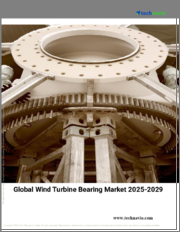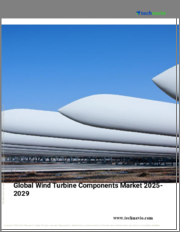
|
시장보고서
상품코드
1719275
풍력 터빈용 변압기 시장 : 세계 산업 규모, 점유율, 동향, 기회, 예측 - 유형별(승압, 강압), 용도별(육상, 해상), 전압별(저, 중, 고), 지역별, 경쟁별(2020-2030년)Wind Turbine Transformers Market - Global Industry Size, Share, Trends, Opportunity, and Forecast, Segmented, By Type (Step-Up, Step-Down), By Application (Onshore, Offshore), and By Voltage (Low, Medium, High), By Region, By Competition, 2020-2030F |
||||||
풍력 터빈용 변압기 세계 시장 규모는 2024년에 25억 1,000만 달러, 2030년에는 45억 4,000만 달러에 달할 것으로 예상되며, 예측 기간 동안 10.22%의 CAGR로 성장할 것으로 예상됩니다.
| 시장 개요 | |
|---|---|
| 예측 기간 | 2026-2030년 |
| 시장 규모 : 2024년 | 25억 1,000만 달러 |
| 시장 규모 : 2030년 | 45억 4,000만 달러 |
| CAGR : 2025-2030년 | 10.22% |
| 급성장 부문 | 강압 |
| 최대 시장 | 북미 |
이 시장은 육상 및 해상 풍력발전 애플리케이션에 특화된 변압기의 설계, 제조 및 배치에 중점을 둔 세계 산업을 의미합니다. 이 변압기는 풍력 터빈에서 생산된 전력을 효율적으로 변환하여 전력망으로 전송하는 데 필수적입니다. 변압기는 전압 레벨을 승압 또는 강압하여 송전 중 에너지 손실을 최소화하고 풍력발전 시스템의 안전하고 안정적인 작동을 보장합니다.
이 시장에는 건식, 침수식, 가스 절연 변압기 등 다양한 유형의 변압기가 있으며, 최신 풍력발전소의 다양한 환경 요구 사항과 기술 요구 사항을 충족합니다.
주요 시장 촉진요인
전 세계 풍력에너지 인프라 확대
주요 시장 과제
높은 초기 투자 및 설치 비용
주요 시장 동향
스마트 그리드 기술과 디지털화의 통합
풍력 터빈용 변압기 시장은 효율성, 신뢰성, 시스템 인텔리전스를 강화하기 위해 스마트 그리드 기술과 디지털화 채택이 증가하고 있습니다.
최신 변압기에는 IoT 지원 센서가 탑재되어 전압, 온도, 부하 상태 등 주요 성능 지표를 실시간으로 모니터링할 수 있습니다.
목차
제1장 개요
제2장 조사 방법
제3장 주요 요약
제4장 고객의 소리
제5장 세계의 풍력 터빈용 변압기 시장 전망
- 시장 규모 및 예측
- 금액별
- 시장 점유율과 예측
- 유형별(승압, 강압)
- 용도별(육상, 해상)
- 전압별(저, 중, 고)
- 지역별
- 기업별(2024)
- 시장 맵
제6장 북미의 풍력 터빈용 변압기 시장 전망
- 시장 규모 및 예측
- 시장 점유율과 예측
- 북미 : 국가별 분석
- 미국
- 캐나다
- 멕시코
제7장 유럽의 풍력 터빈용 변압기 시장 전망
- 시장 규모 및 예측
- 시장 점유율과 예측
- 유럽 : 국가별 분석
- 독일
- 영국
- 이탈리아
- 프랑스
- 스페인
제8장 아시아태평양의 풍력 터빈용 변압기 시장 전망
- 시장 규모 및 예측
- 시장 점유율과 예측
- 아시아태평양 : 국가별 분석
- 중국
- 인도
- 일본
- 한국
- 호주
제9장 남미의 풍력 터빈용 변압기 시장 전망
- 시장 규모 및 예측
- 시장 점유율과 예측
- 남미 : 국가별 분석
- 브라질
- 아르헨티나
- 콜롬비아
제10장 중동 및 아프리카의 풍력 터빈용 변압기 시장 전망
- 시장 규모 및 예측
- 시장 점유율과 예측
- 중동 및 아프리카 : 국가별 분석
- 남아프리카공화국
- 사우디아라비아
- 아랍에미리트
- 쿠웨이트
- 튀르키예
제11장 시장 역학
- 성장 촉진요인
- 과제
제12장 시장 동향과 발전
- 인수합병
- 제품 출시
- 최근 동향
제13장 기업 개요
- Eaton Corporation
- Hammond Power Solutions
- Hitachi Limited
- ABB Ltd.
- Bharat Heavy Electricals Limited,
- Siemens AG
- DAIHEN Corporation
- CG Power and Industrial Solutions Ltd,
- GE Renewable Energy
- Mitsubishi Electric Corporation
제14장 전략적 제안
제15장 조사 회사 소개 및 면책사항
ksm 25.05.23The Global Wind Turbine Transformers Market was valued at USD 2.51 billion in 2024 and is projected to reach USD 4.54 billion by 2030, growing at a CAGR of 10.22% during the forecast period.
| Market Overview | |
|---|---|
| Forecast Period | 2026-2030 |
| Market Size 2024 | USD 2.51 Billion |
| Market Size 2030 | USD 4.54 Billion |
| CAGR 2025-2030 | 10.22% |
| Fastest Growing Segment | Step-Down |
| Largest Market | North America |
The market refers to the global industry focused on the design, production, and deployment of transformers specifically engineered for wind energy applications, both onshore and offshore. These transformers are critical in efficiently converting and transmitting electricity generated by wind turbines to the power grid. They help step up or step down voltage levels, minimize energy losses during transmission, and ensure safe and stable operation of wind power systems.
The market spans a variety of transformer types, including dry-type, liquid-immersed, and gas-insulated transformers, tailored to meet the diverse environmental and technical requirements of modern wind farms.
Key Market Drivers
Global Expansion of Wind Energy Infrastructure
The worldwide push for renewable energy adoption has led to significant growth in wind energy infrastructure, which in turn is driving the Wind Turbine Transformers Market. Governments across the globe are setting aggressive targets to lower carbon emissions, with wind energy playing a central role in these efforts.
In 2023, a record 117 GW of new wind capacity was installed globally-a 50% increase over 2022-bringing total global wind capacity to over 1,020 GW. China led this growth by adding approximately 76.7 GW, accounting for over 65% of global installations.
The rapid expansion of wind farms, both onshore and offshore, highlights the growing need for advanced transformer solutions capable of handling varying environmental conditions and load demands. As the scale and complexity of projects increase, the demand for high-efficiency, robust transformers designed to manage grid integration challenges and ensure system stability is expected to rise significantly.
Key Market Challenges
High Initial Investment and Installation Costs
A major challenge for the Wind Turbine Transformers Market is the high initial investment and installation costs associated with these systems. Due to the harsh environmental conditions faced-especially in offshore applications-transformers require specialized materials and advanced engineering, driving up production costs.
Furthermore, transporting and installing heavy transformer units in remote or offshore locations incurs additional expenses, including foundation preparation, crane operations, specialized vessels, and skilled labor.
For emerging economies and developing renewable markets, these capital-intensive requirements can slow down project timelines. Long payback periods, combined with potential revenue uncertainties due to fluctuating energy prices or policy changes, further discourage investment, even as the overall cost of wind energy continues to decline.
Key Market Trends
Integration of Smart Grid Technologies and Digitalization
The Wind Turbine Transformers Market is witnessing increasing adoption of smart grid technologies and digitalization to enhance efficiency, reliability, and system intelligence.
Modern transformers are now equipped with IoT-enabled sensors that enable real-time monitoring of key performance metrics, such as voltage, temperature, and load conditions.
This facilitates predictive maintenance, helping operators detect and resolve potential issues early, thereby minimizing downtime. Additionally, smart transformers support dynamic voltage regulation and reactive power compensation, critical for maintaining grid stability amid the variable nature of wind energy.
As energy networks evolve toward smarter, more complex infrastructures, the role of digitalized transformers becomes pivotal in enabling the seamless integration of renewables into the global grid.
Key Market Players
- Eaton Corporation
- Hammond Power Solutions
- Hitachi Limited
- ABB Ltd.
- Bharat Heavy Electricals Limited
- Siemens AG
- DAIHEN Corporation
- CG Power and Industrial Solutions Ltd.
- GE Renewable Energy
- Mitsubishi Electric Corporation
Report Scope:
In this report, the Global Wind Turbine Transformers Market has been segmented into the following categories, along with detailed industry trend analysis:
Wind Turbine Transformers Market, By Type:
- Step-Up
- Step-Down
Wind Turbine Transformers Market, By Application:
- Onshore
- Offshore
Wind Turbine Transformers Market, By Voltage:
- Low
- Medium
- High
Wind Turbine Transformers Market, By Region:
- North America
- United States
- Canada
- Mexico
- Europe
- France
- United Kingdom
- Italy
- Germany
- Spain
- Asia-Pacific
- China
- India
- Japan
- Australia
- South Korea
- South America
- Brazil
- Argentina
- Colombia
- Middle East & Africa
- South Africa
- Saudi Arabia
- UAE
- Kuwait
- Turkey
Competitive Landscape
Company Profiles: Detailed analysis of major companies operating in the Global Wind Turbine Transformers Market.
Available Customizations:
With the given market data, TechSci Research offers customized reporting solutions tailored to specific business needs, including:
- Detailed analysis and profiling of additional market players (up to five).
Table of Contents
1. Product Overview
- 1.1. Market Definition
- 1.2. Scope of the Market
- 1.2.1. Markets Covered
- 1.2.2. Years Considered for Study
- 1.3. Key Market Segmentations
2. Research Methodology
- 2.1. Objective of the Study
- 2.2. Baseline Methodology
- 2.3. Formulation of the Scope
- 2.4. Assumptions and Limitations
- 2.5. Sources of Research
- 2.5.1. Secondary Research
- 2.5.2. Primary Research
- 2.6. Approach for the Market Study
- 2.6.1. The Bottom-Up Approach
- 2.6.2. The Top-Down Approach
- 2.7. Methodology Followed for Calculation of Market Size & Market Shares
- 2.8. Forecasting Methodology
- 2.8.1. Data Triangulation & Validation
3. Executive Summary
- 3.1. Overview of the Market
- 3.2. Overview of Key Market Segmentations
- 3.3. Overview of Key Market Players
- 3.4. Overview of Key Regions/Countries
- 3.5. Overview of Market Drivers, Challenges, and Trends
4. Voice of Customer
5. Global Wind Turbine Transformers Market Outlook
- 5.1. Market Size & Forecast
- 5.1.1. By Value
- 5.2. Market Share & Forecast
- 5.2.1. By Type (Step-Up, Step-Down)
- 5.2.2. By Application (Onshore, Offshore)
- 5.2.3. By Voltage (Low, Medium, High)
- 5.2.4. By Region
- 5.3. By Company (2024)
- 5.4. Market Map
6. North America Wind Turbine Transformers Market Outlook
- 6.1. Market Size & Forecast
- 6.1.1. By Value
- 6.2. Market Share & Forecast
- 6.2.1. By Type
- 6.2.2. By Application
- 6.2.3. By Voltage
- 6.2.4. By Country
- 6.3. North America: Country Analysis
- 6.3.1. United States Wind Turbine Transformers Market Outlook
- 6.3.1.1. Market Size & Forecast
- 6.3.1.1.1. By Value
- 6.3.1.2. Market Share & Forecast
- 6.3.1.2.1. By Type
- 6.3.1.2.2. By Application
- 6.3.1.2.3. By Voltage
- 6.3.1.1. Market Size & Forecast
- 6.3.2. Canada Wind Turbine Transformers Market Outlook
- 6.3.2.1. Market Size & Forecast
- 6.3.2.1.1. By Value
- 6.3.2.2. Market Share & Forecast
- 6.3.2.2.1. By Type
- 6.3.2.2.2. By Application
- 6.3.2.2.3. By Voltage
- 6.3.2.1. Market Size & Forecast
- 6.3.3. Mexico Wind Turbine Transformers Market Outlook
- 6.3.3.1. Market Size & Forecast
- 6.3.3.1.1. By Value
- 6.3.3.2. Market Share & Forecast
- 6.3.3.2.1. By Type
- 6.3.3.2.2. By Application
- 6.3.3.2.3. By Voltage
- 6.3.3.1. Market Size & Forecast
- 6.3.1. United States Wind Turbine Transformers Market Outlook
7. Europe Wind Turbine Transformers Market Outlook
- 7.1. Market Size & Forecast
- 7.1.1. By Value
- 7.2. Market Share & Forecast
- 7.2.1. By Type
- 7.2.2. By Application
- 7.2.3. By Voltage
- 7.2.4. By Country
- 7.3. Europe: Country Analysis
- 7.3.1. Germany Wind Turbine Transformers Market Outlook
- 7.3.1.1. Market Size & Forecast
- 7.3.1.1.1. By Value
- 7.3.1.2. Market Share & Forecast
- 7.3.1.2.1. By Type
- 7.3.1.2.2. By Application
- 7.3.1.2.3. By Voltage
- 7.3.1.1. Market Size & Forecast
- 7.3.2. United Kingdom Wind Turbine Transformers Market Outlook
- 7.3.2.1. Market Size & Forecast
- 7.3.2.1.1. By Value
- 7.3.2.2. Market Share & Forecast
- 7.3.2.2.1. By Type
- 7.3.2.2.2. By Application
- 7.3.2.2.3. By Voltage
- 7.3.2.1. Market Size & Forecast
- 7.3.3. Italy Wind Turbine Transformers Market Outlook
- 7.3.3.1. Market Size & Forecast
- 7.3.3.1.1. By Value
- 7.3.3.2. Market Share & Forecast
- 7.3.3.2.1. By Type
- 7.3.3.2.2. By Application
- 7.3.3.2.3. By Voltage
- 7.3.3.1. Market Size & Forecast
- 7.3.4. France Wind Turbine Transformers Market Outlook
- 7.3.4.1. Market Size & Forecast
- 7.3.4.1.1. By Value
- 7.3.4.2. Market Share & Forecast
- 7.3.4.2.1. By Type
- 7.3.4.2.2. By Application
- 7.3.4.2.3. By Voltage
- 7.3.4.1. Market Size & Forecast
- 7.3.5. Spain Wind Turbine Transformers Market Outlook
- 7.3.5.1. Market Size & Forecast
- 7.3.5.1.1. By Value
- 7.3.5.2. Market Share & Forecast
- 7.3.5.2.1. By Type
- 7.3.5.2.2. By Application
- 7.3.5.2.3. By Voltage
- 7.3.5.1. Market Size & Forecast
- 7.3.1. Germany Wind Turbine Transformers Market Outlook
8. Asia-Pacific Wind Turbine Transformers Market Outlook
- 8.1. Market Size & Forecast
- 8.1.1. By Value
- 8.2. Market Share & Forecast
- 8.2.1. By Type
- 8.2.2. By Application
- 8.2.3. By Voltage
- 8.2.4. By Country
- 8.3. Asia-Pacific: Country Analysis
- 8.3.1. China Wind Turbine Transformers Market Outlook
- 8.3.1.1. Market Size & Forecast
- 8.3.1.1.1. By Value
- 8.3.1.2. Market Share & Forecast
- 8.3.1.2.1. By Type
- 8.3.1.2.2. By Application
- 8.3.1.2.3. By Voltage
- 8.3.1.1. Market Size & Forecast
- 8.3.2. India Wind Turbine Transformers Market Outlook
- 8.3.2.1. Market Size & Forecast
- 8.3.2.1.1. By Value
- 8.3.2.2. Market Share & Forecast
- 8.3.2.2.1. By Type
- 8.3.2.2.2. By Application
- 8.3.2.2.3. By Voltage
- 8.3.2.1. Market Size & Forecast
- 8.3.3. Japan Wind Turbine Transformers Market Outlook
- 8.3.3.1. Market Size & Forecast
- 8.3.3.1.1. By Value
- 8.3.3.2. Market Share & Forecast
- 8.3.3.2.1. By Type
- 8.3.3.2.2. By Application
- 8.3.3.2.3. By Voltage
- 8.3.3.1. Market Size & Forecast
- 8.3.4. South Korea Wind Turbine Transformers Market Outlook
- 8.3.4.1. Market Size & Forecast
- 8.3.4.1.1. By Value
- 8.3.4.2. Market Share & Forecast
- 8.3.4.2.1. By Type
- 8.3.4.2.2. By Application
- 8.3.4.2.3. By Voltage
- 8.3.4.1. Market Size & Forecast
- 8.3.5. Australia Wind Turbine Transformers Market Outlook
- 8.3.5.1. Market Size & Forecast
- 8.3.5.1.1. By Value
- 8.3.5.2. Market Share & Forecast
- 8.3.5.2.1. By Type
- 8.3.5.2.2. By Application
- 8.3.5.2.3. By Voltage
- 8.3.5.1. Market Size & Forecast
- 8.3.1. China Wind Turbine Transformers Market Outlook
9. South America Wind Turbine Transformers Market Outlook
- 9.1. Market Size & Forecast
- 9.1.1. By Value
- 9.2. Market Share & Forecast
- 9.2.1. By Type
- 9.2.2. By Application
- 9.2.3. By Voltage
- 9.2.4. By Country
- 9.3. South America: Country Analysis
- 9.3.1. Brazil Wind Turbine Transformers Market Outlook
- 9.3.1.1. Market Size & Forecast
- 9.3.1.1.1. By Value
- 9.3.1.2. Market Share & Forecast
- 9.3.1.2.1. By Type
- 9.3.1.2.2. By Application
- 9.3.1.2.3. By Voltage
- 9.3.1.1. Market Size & Forecast
- 9.3.2. Argentina Wind Turbine Transformers Market Outlook
- 9.3.2.1. Market Size & Forecast
- 9.3.2.1.1. By Value
- 9.3.2.2. Market Share & Forecast
- 9.3.2.2.1. By Type
- 9.3.2.2.2. By Application
- 9.3.2.2.3. By Voltage
- 9.3.2.1. Market Size & Forecast
- 9.3.3. Colombia Wind Turbine Transformers Market Outlook
- 9.3.3.1. Market Size & Forecast
- 9.3.3.1.1. By Value
- 9.3.3.2. Market Share & Forecast
- 9.3.3.2.1. By Type
- 9.3.3.2.2. By Application
- 9.3.3.2.3. By Voltage
- 9.3.3.1. Market Size & Forecast
- 9.3.1. Brazil Wind Turbine Transformers Market Outlook
10. Middle East and Africa Wind Turbine Transformers Market Outlook
- 10.1. Market Size & Forecast
- 10.1.1. By Value
- 10.2. Market Share & Forecast
- 10.2.1. By Type
- 10.2.2. By Application
- 10.2.3. By Voltage
- 10.2.4. By Country
- 10.3. Middle East and Africa: Country Analysis
- 10.3.1. South Africa Wind Turbine Transformers Market Outlook
- 10.3.1.1. Market Size & Forecast
- 10.3.1.1.1. By Value
- 10.3.1.2. Market Share & Forecast
- 10.3.1.2.1. By Type
- 10.3.1.2.2. By Application
- 10.3.1.2.3. By Voltage
- 10.3.1.1. Market Size & Forecast
- 10.3.2. Saudi Arabia Wind Turbine Transformers Market Outlook
- 10.3.2.1. Market Size & Forecast
- 10.3.2.1.1. By Value
- 10.3.2.2. Market Share & Forecast
- 10.3.2.2.1. By Type
- 10.3.2.2.2. By Application
- 10.3.2.2.3. By Voltage
- 10.3.2.1. Market Size & Forecast
- 10.3.3. UAE Wind Turbine Transformers Market Outlook
- 10.3.3.1. Market Size & Forecast
- 10.3.3.1.1. By Value
- 10.3.3.2. Market Share & Forecast
- 10.3.3.2.1. By Type
- 10.3.3.2.2. By Application
- 10.3.3.2.3. By Voltage
- 10.3.3.1. Market Size & Forecast
- 10.3.4. Kuwait Wind Turbine Transformers Market Outlook
- 10.3.4.1. Market Size & Forecast
- 10.3.4.1.1. By Value
- 10.3.4.2. Market Share & Forecast
- 10.3.4.2.1. By Type
- 10.3.4.2.2. By Application
- 10.3.4.2.3. By Voltage
- 10.3.4.1. Market Size & Forecast
- 10.3.5. Turkey Wind Turbine Transformers Market Outlook
- 10.3.5.1. Market Size & Forecast
- 10.3.5.1.1. By Value
- 10.3.5.2. Market Share & Forecast
- 10.3.5.2.1. By Type
- 10.3.5.2.2. By Application
- 10.3.5.2.3. By Voltage
- 10.3.5.1. Market Size & Forecast
- 10.3.1. South Africa Wind Turbine Transformers Market Outlook
11. Market Dynamics
- 11.1. Drivers
- 11.2. Challenges
12. Market Trends & Developments
- 12.1. Merger & Acquisition (If Any)
- 12.2. Product Launches (If Any)
- 12.3. Recent Developments
13. Company Profiles
- 13.1. Eaton Corporation
- 13.1.1. Business Overview
- 13.1.2. Key Revenue and Financials
- 13.1.3. Recent Developments
- 13.1.4. Key Personnel/Key Contact Person
- 13.1.5. Key Product/Services Offered
- 13.2. Hammond Power Solutions
- 13.3. Hitachi Limited
- 13.4. ABB Ltd.
- 13.5. Bharat Heavy Electricals Limited,
- 13.6. Siemens AG
- 13.7. DAIHEN Corporation
- 13.8. CG Power and Industrial Solutions Ltd,
- 13.9. GE Renewable Energy
- 13.10. Mitsubishi Electric Corporation



















